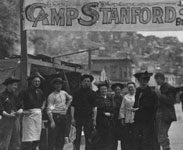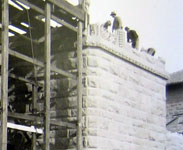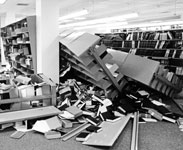|
|
||||||||||
 |
|
|
|
|||||||
|
|
||||||||||
|
|
|
|
|
|
|
|
|
|||
|
|
|
|
|
|
|
|
|
|
|
|
Themes
|
|
Walking Tour Topics
Click on a topic to view the information assembled for the Walking Tour:
| The original block of the Leland Stanford Junior Museum survived the 1906 earthquake because of its innovative design and reinforced concrete construction. Damaged again in 1989, the museum was closed for 10 years and after a major renovation was reborn as the Cantor Center for the Visual Arts -- a cultural hub for students and scholars. | Standing in front of the now-abandoned Old Chem building, find out how decisions are made after a major earthquake on whether to repair, redevelop or demolish damaged buildings. In conjunction with Jane Stanford’s Library and Gymnasium—which were constructed during Stanford’s ‘second stone age’ and destroyed in 1906—the history of Old Chem provides insight into these decisions. | Images of the broken Memorial Arch that once graced the entry to the Main Quad contributed to impressions that diminished Stanford’s national reputation, which took more than a decade to rebuild. Amidst the distruction, the fallen statue of the naturalist Agassiz provided some comic relief, as President David Starr Jordan wrote, “Somebody—Dr. Angell, perhaps—remarked that ‘Agassiz was great in the abstract but not in the concrete.’ |
| 4: Repair of Monuments | 5: Evolution of Engineering Methods | 6: Earthquakes and Student Life |
Described by alumnus Mel Lane as the “heart of the quad”, Memorial Church was devastated by the 1906 earthquake, rebuilt by 1914, and then heavily damaged again in the 1989 Loma Prieta earthquake. With the loss of its spire in 1906, its appearance was forever changed, but its symbolic and spiritual place in the University persevered. Seismically repaired and retrofitted since 1989, Memorial Church and its connection to Stanford’s past will endure for future generations to enjoy. |
The Main Quad is a fascinating example of how earthquake engineering methods have evolved, from the 1960’s “gut and stuff” method empolyed at the Math Corner to the retrofit of the Language Corner in the 1990’s, intended to perserve the historic look and feel of the quad. Visit building 30 to see a wall that was left unfinished to provide visitors with an understanding of the original construction and reconstruction of the Main Quad. |
The site of the only Stanford student earthquake fatality, Encina Hall at first experienced pandemonium when its undergraduate residents were rudely shaken from their beds at 5:12 AM on April 18, 1906. According to the Quad, “The shaking of the building was so violent that it was difficult for one to keep one’s feet.” Composure was soon regained in a temporary tent city, from which students participated in recovery efforts at Stanford and San Francisco. |
| 7: Earthquake Economics | 8: Emergency Preparedness | 9: Academic Contributions |
The Bing Wing of Green Library is a remarkable look at how Stanford was able to recover from the 1989 Loma Prieta Earthquake. Forced to self-insure for earthquake risks, and facing building damage from the 1989 earthquake in excess of $160 million, Stanford relied on support from FEMA, alumni donations, and its endowment to recover. |
As a self-sustaining community, Stanford University is prepared to take care for approximately 10,000 students, staff and faculty in the event of a major eathquake. At the site of the original campus powerhouse (the site of the second fatality at Stanford) find out what happened in 1906, how Stanford responded in 1989, and what measures have been implemented for the future. |
The quake of 1906 spurred research at Stanford University in engineering and earth sciences related to the cause and effect of earthquakes. Pioneering researchers, including Profs. F.J. Rogers, Bailey Willis, and Lydik Jacobsen established Stanford’s leadership in earthquake engineering. A graduate of the mid-1930’s, John A. Blume, considered a “father of modern earthquake engineering”, went on to establish a center to maintain Stanford’s contributions in the field. |
| 10: Evolution of Codes | 11: Plate Tectonics & Seismic Hazards | |
Building codes have existed for centuries as a way of ensuring safety and reducing damage. In California, the codes have evolved as deficiencies were discovered after major quakes, and new research methods are discovered. As part of its program of self-insurance, Stanford determined that The Mitchell Building, built to code in the 1960’s, was not in compliance with modern codes and seismically retrofitted it in 1997 |
Beyond its immediate devastation to the San Francisco Bay Area, the 1906 earthquake provided important scientific data. Analysis of this data helped firmly establish the Elastic Rebound Theory to explain earthquake events, which led to a broader understanding of plate tectonics. These fundamental theories, together with ongoing data collection and analysis, enable scientists to assess the likelihood of future earthquake hazards, a first step in hazard mitigation. |


